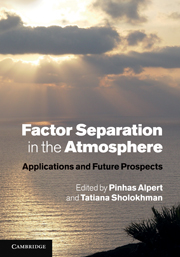Book contents
- Frontmatter
- Contents
- List of contributors
- Foreword
- Preface
- 1 Introduction
- 2 The Factor Separation Methodology and the fractional approach
- 3 Investigation of the Factor Separation features for basic mathematical functions
- 4 Factor Separation Methodology and paleoclimates
- 5 Meso-meteorology: Factor Separation examples in atmospheric meso-scale motions
- 6 Using the Alpert–Stein Factor Separation Methodology for land-use land-cover change impacts on weather and climate process with the Regional Atmospheric Modeling System
- 7 Application of Factor Separation to heavy rainfall and cyclogenesis: Mediterranean examples
- 8 Experience in applying the Alpert–Stein Factor Separation Methodology to assessing urban land-use and aerosol impacts on precipitation
- 9 Free and forced thermocline oscillations in Lake Tanganyika
- 10 Application of the Factor Separation Methodology to quantify the effect of waste heat, vapor and pollution on cumulus convection
- 11 The use of the Alpert–Stein Factor Separation Methodology for climate variable interaction studies in hydrological land surface models and crop yield models
- 12 Linear model for the sea breeze
- 13 Experience and conclusions from the Alpert–Stein Factor Separation Methodology
- 14 Tagging systematic errors arising from different components of dynamics and physics in forecast models
- 15 Some difficulties and prospects
- 16 Summary
- Appendix: References employing the Alpert–Stein Factor Separation Methodology
- References
- Index
7 - Application of Factor Separation to heavy rainfall and cyclogenesis: Mediterranean examples
Published online by Cambridge University Press: 03 May 2011
- Frontmatter
- Contents
- List of contributors
- Foreword
- Preface
- 1 Introduction
- 2 The Factor Separation Methodology and the fractional approach
- 3 Investigation of the Factor Separation features for basic mathematical functions
- 4 Factor Separation Methodology and paleoclimates
- 5 Meso-meteorology: Factor Separation examples in atmospheric meso-scale motions
- 6 Using the Alpert–Stein Factor Separation Methodology for land-use land-cover change impacts on weather and climate process with the Regional Atmospheric Modeling System
- 7 Application of Factor Separation to heavy rainfall and cyclogenesis: Mediterranean examples
- 8 Experience in applying the Alpert–Stein Factor Separation Methodology to assessing urban land-use and aerosol impacts on precipitation
- 9 Free and forced thermocline oscillations in Lake Tanganyika
- 10 Application of the Factor Separation Methodology to quantify the effect of waste heat, vapor and pollution on cumulus convection
- 11 The use of the Alpert–Stein Factor Separation Methodology for climate variable interaction studies in hydrological land surface models and crop yield models
- 12 Linear model for the sea breeze
- 13 Experience and conclusions from the Alpert–Stein Factor Separation Methodology
- 14 Tagging systematic errors arising from different components of dynamics and physics in forecast models
- 15 Some difficulties and prospects
- 16 Summary
- Appendix: References employing the Alpert–Stein Factor Separation Methodology
- References
- Index
Summary
Heavy precipitation and intense cyclones exert a high societal impact in the Mediterranean region. Factor Separation (FS) by means of numerical simulations is a well-suited tool for improving our physical understanding of these phenomena. The roles played by boundary factors, such as the orography and surface heat fluxes, or by physical factors, such as the condensational latent heat release, have been isolated in numerous case studies. More recently, prognostic and diagnostic tools have been applied to also isolate the forcing associated with dynamical factors, such as the upper-level potential vorticity anomalies that tend to accompany the Mediterranean stormy weather.
Introduction
The Mediterranean basin is an ideal atmospheric research ‘laboratory’, recognized as one of the world's major cyclogenetic areas (Pettersen 1956, Radinovic, 1987). Much of the high-impact weather (notably strong winds and heavy precipitation) affecting its coastal countries has been statistically associated with the near presence of a distinct cyclonic signature (e.g., Jansá et al., 2001). The numerical modelling of these atmospheric circulations is the most powerful tool available to scientists to develop a better physical understanding of the responsible mechanisms. In particular, many studies have used this potential to isolate the role played by different physical factors by means of the factor separation technique. Boundary factors (e.g., orography and latent heat flux from the Mediterranean) and model physics factors (e.g., latent heat release in cloud systems) have been typically considered. Some results on the role of both types of factors in Mediterranean flash flood events will be discussed in Section 7.2.
- Type
- Chapter
- Information
- Factor Separation in the AtmosphereApplications and Future Prospects, pp. 87 - 119Publisher: Cambridge University PressPrint publication year: 2011
- 1
- Cited by



